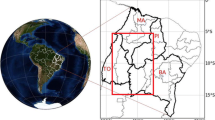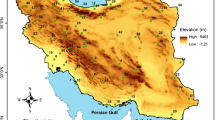Abstract
An investigation of climatic extreme events presents the valuable opportunities to evaluate the potential impacts of climate change on human activities, agriculture, and economy. These analyses are useful procedures in monitoring climate change on a synoptic scale. The present study is a trend analysis of the extreme temperature events, which have been based on the gridded daily temperatures of Iranian climatic database within 1962–2004. The aim of the present study is to identify the frequency and intensity of extreme events, which have been increased with over Iran in the last four decades. Both the Mann–Kendall trend test and simple linear regression were utilized to detect trends in annual temperature extremes. The results showed that the frequency of hot extreme temperature events has increased over the study area within 1962–2004, while a negative trend has been observed in the frequency of cold extreme temperatures. About 66 % of the surface area has a significant positive trend in frequency of hot days and nights, while about 40.9 and 68.5 % of surface area have a significant decrease in frequency of cold days and nights, respectively. The strongest increasing tendency is detected in the case of the annual numbers of hot nights, warm nights, summer days, warm days, and the heat wave duration indices.






Similar content being viewed by others
References
Alexander LV, Zhang X, Peterson TC, Caesar J, Gleason B, Klein Tank AMG, Haylock M, Collins D, Trewin B, Rahimzadeh F, Tagipour A, Rupa Kumar K, Revadekar J, Griffiths G, Vincent L, Stephenson DB, Burn J, Aguilar E, Brunet M, Taylor M, New M, Zhai P, Rusticucci M, Vazquez-Aguirre JL (2006) Global observed changes in daily climate extremes of temperature and precipitation. J Geophys Res Atmos 111(D05109):1–22
Debesch H, Dumolard P, Dyras I (2010) Spatial interpolation for climate data: the use of GIS in climatology and meteorology. Wiley–ISTE, California, p 284
Easterling DR, Evans JL, Gorssmam PY, Karl TR, Kunkel KE, Ambenje P (2000a) Observed variability and trends in extreme climate events: brief review. Bull Am Meteorol Soc 81(3):417–425
Easterling DR, Meehl GA, Parmesan C, Chngnon SA, Karl TR, Mearns LO (2000b) Climate extremes: observation, modeling and impacts. Science 289(5487):2068–2074
Goovaerts P (1997) Geostatistics for natural resources evaluation. Oxford, New York, p 483
Haylock MR, Hofstra N, Klein Tank AMG, Klok EJ, Jones PD, New M (2008) A European daily high-resolution gridded data set of surface temperature and precipitation for 1950–2006. J Geophys Res Atmos 113(D20119):1–12
Hijmans RJ, Cameron SE, Parra JL, Jones PG, Jarvis A (2005) Very high resolution interpolated climate surfaces for global land areas. Int J Climatol 25(15):1965–1978
Hofstra N, Haylock M, New M, Jones P, Frei C (2008) Comparison of six methods for the interpolation of daily, European climate data. J Geophys Res Atmos 113(D21110):1–19
Hyun SJ, Choi Y, Gyu-Holim J (2002) Recent trends in temperature and precipitation over South Korea. Int J Climatol 22(11):1327–1337
IPCC (2001) Climate change 2001: impacts, adaptation, and vulnerability. Contribution of Working Group II to the Third Assessment Report of the Intergovernmental Panel on Climate Change. Cambridge University Press
IPCC (2007) Climate change 2007—the physical science basis. Contribution of working group I to the fourth assessment report of the IPCC. Cambridge University Press, Cambridge
IPCC (2012) Changes in climate extremes and their impacts on the natural physical environment. Cambridge University Press, Cambridge
Johnston K, Ver Hoef JM, Krivoruchko K, and Lucas N (2001) Using ArcGIS Geostatistical Analyst, ESRI, 316 pp
Karl TR, Easterling DR (1999) Climate extremes: selected review and future research directions. Clim Chang 42(1):309–325
Karl TR, Knight RW, Easterling DR, Quayle RG (1996) Indices of climate change for United States. Bull Am Meteorol Soc 77(2):279–292
Kendall MG (1962) Rank correlation methods. Hafner Publishing Company, New York
Kioutsioukis I, Melas D, Zerefos C (2009) Statistical assessment of changes in climate extremes over Greece (1955–2002). Int J Climatol 30(11):1723–1737
Klein Tank AMG, Peterson TC, Quadir DA, Dorji S, Zou X, Tang H, Santhosh K, Joshi UR, Jaswal AK, Kolli RK, Sikder AB, Deshpande NR, Revadekar JV, Yeleuova K, Vandasheva S, Faleyeva M, Gomboluudev P, Budhathoki KP, Hussain A, Afzaal M, Chandrapala L, Anvar H, Amanmurad D, Asanova VS, Jones PD, New MG, Spektorman T (2006) Changes in daily temperature and precipitation extremes in Central and South Asia. J Geophys Res Atmos 111(D16105):1–8
Kunkel KE, Pritke RA, Changnon SA (1999) Temporal fluctuation in weather and climate extremes that cause economic and human health impacts: a review. Bull Am Meteorol Soc 80(6):1077–1098
Mann HB (1945) Non-parametric test against trend. Econometrika 13:245–259
Mansouri Daneshvar MR, Bagherzadeh A, Tavousi T (2013) Assessment of bioclimatic comfort conditions based on physiologically equivalent temperature (PET) using the RayMan model in Iran. Cent Eur J Geosci 5(1):53–60
Manton MJ, Della-Marta PM, Haylock MR, Hennessy KJ, Nicholls N, Chambers LE, Collins DA, Daw G, Finet A, Gunawan D, Inape K, Isobe H, Kestin TS, Lafale P, Leyu CH, Lwin T, Maitrepierre L, Ouprasitwong N, Page CM, Pahalad J, Plummer N, Salinger MJ, Suppiah R, Tran VL, Trewin B, Tibig I, Yee D (2001) Trends in extreme daily rainfall and temperature in Southern Asia and the South Pacific: 1961–1998. Int J Climatol 21(3):269–284
Marofi S, Sohrabi MM, Mohammadi K, Sabziparvar AA (2011) Investigation of meteorological extreme events over coastal regions of Iran. Theor Appl Climatol 103(3–4):401–412
Nalder IA, Wein RW (1998) Spatial interpolation of climatic normals: test of a new method in the Canadian boreal forest. Agric For Meteorol 92(4):211–225
Nasrabadi E, Masoodian A, Asakereh H (2013) Comparison of gridded precipitation time series data in APHRODITE and Asfazari databases within Iran’s territory. Atmos Clim Sci 3:235
Nasrallah HA, Nieplova E, Ramadan E (2004) Warm season extreme temperature events in Kuwait. J Arid Environ 56(2):357–371
Nazaripour H, Mansouri Daneshvar MR (2014) Spatial contribution of one-day precipitations variability to rainy days and rainfall amounts in Iran. Int J Environ Sci Technol 11(6):1751–1758
Plummer N, Salinger MJ, Nicholls N, Suppich R, Hennessy KJ, Leigthan RM, Treulin BC, Page CM, Lough JM (1999) Changes in climate extreme over the Australian region and New Zealand during the twentieth century. Clim Chang 42(1):183–202
Rahimzadeh F, Asgari A, Fattahi E (2009) Variability of extreme temperature and precipitation in Iran during recent decades. Int J Climatol 29(3):329–343
Revadekar JV, Kothawale DR, Rupa Kumar K (2009) Role of El Niño/La Niña in temperature extremes over India. Int J Climatol 29(14):2121–2129
Rusticucci M, Renom M (2008) Variability and trends in indices of quality-controlled daily temperature extremes in Uruguay. Int J Climatol 28(8):1083–1095
Salas JD (1993) Analysis and modeling of hydrologic time-series. In: Maidment DR (ed) Handbook of hydrology. McGraw–Hill, New York, pp 19.1–19.72
Santos CAC, Neale CMU, Rao TVR, Silva BB (2010) Trends in indices for extremes in daily temperature and precipitation over Utah, USA. Int J Climatol 31(2):1813–1822
Van den Besselaar EJM, Haylock MR, Van der Schrier G, Klein Tank AMG (2011) A European daily high-resolution observational gridded data set of sea level pressure. J Geophys Res Atmos 116(D11110):1–11
Varfi MS, Karacostas TS, Makrogiannis TJ, Flocas AA (2009) Characteristics of the extreme warm and cold days over Greece. Adv Geosci 20:45–50
Vincent LA, Peterson TC, Barros VR, Marino MB, Rusticucci M, Carrasco G, Ramirez E, Alves LM, Ambrizzi T, Berlato MA, Grimm AM, Marengo JA, Molion L, Moncunill DF, Rebello E, Anunciação YMT, Quintana J, Santos JL, Baez J, Coronel G, Garcia J, Trebejo I, Bidegain M, Haylock MR, Karoly D (2005) Observed trends in indices of daily temperature extremes in South America 1960–2000. J Clim 18(23):5011–5023
Xu Y, Changhai X, Xuejie G, Yong L (2009) Projected changes in temperature and precipitation extremes over the Yangtze River Basin of China in the 21st century. Quat Int 208(1–2):44–52
Yan Z, Jones PD, Davies TD, Moberg A, Bergstrom H, Camuffo D, Cocheo C, Maugeri M, Demaraee GR, Verhoeve T, Thoen E, Barriendos M, Prodriguez R, Martin-Vide J, Ynag C (2002) Trends of extreme temperatures in Europe and China based on daily observations. Clim Chang 53(1–3):355–392
Zhang X, Aguilar E, Sensoy S, Melkonyan H, Tagiyeva U, Ahmed N, Kutaladze N, Rahimzadeh F, Taghipour A, Hantosh TH, Albert P, Semawi M, Karam Ali M, Said H, Al-Shabibi M, Al-Oulan, Taha Zatari Z, Al Dean Khelet I, Hammoud S, Demircan M, Eken M, Adiguzel M, Alexander L, Peterson T, Trevor W (2005a) Trends in Middle East climate extremes indices during 1930–2003. J Geophys Res Atmos 110(D22104):1–12
Zhang X, Hegerl G, Zwiers F, Kenyon J (2005b) Avoiding inhomogeneity in percentile-based indices of temperature extremes. J Clim 18(11):1641–1651
Acknowledgments
The authors thank the three anonymous reviewers for their generous suggestions on data analyses and interpretations.
Author information
Authors and Affiliations
Corresponding author
Rights and permissions
About this article
Cite this article
Darand, M., Masoodian, A., Nazaripour, H. et al. Spatial and temporal trend analysis of temperature extremes based on Iranian climatic database (1962–2004). Arab J Geosci 8, 8469–8480 (2015). https://doi.org/10.1007/s12517-015-1840-5
Received:
Accepted:
Published:
Issue Date:
DOI: https://doi.org/10.1007/s12517-015-1840-5




